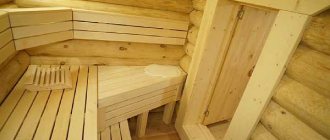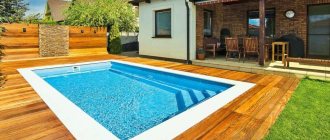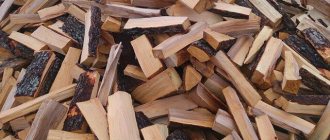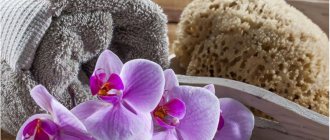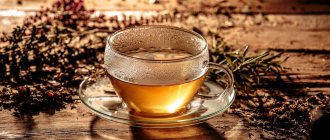It would seem that what is so special about a penny washcloth that you should pay so much attention to it? But for all its simplicity, it can become either your body’s best friend or a source of serious problems.
A body washcloth performs several important functions during washing, and if stored improperly it turns into a breeding ground for germs and bacteria. We tell you how to choose, dry and store it correctly. And at the same time, let’s try to figure out which body washcloths are better – natural or synthetic.
Sand, ash, iron scrapers and other ways to clean up
Once upon a time, our ancestors cleaned the body with simple sand or ash, scraping the skin with special blades made of bronze (for the rich) or wood. To effectively cleanse the body of dirt, sweat and sebum, birch brooms, bast, hemp and other available materials were used. Everything changed in the 30s of the twentieth century with the invention of foam rubber. Foam sponges quickly became the most affordable and popular washing accessory, and thanks to their bright colors and various shapes, they were loved even by children. They were replaced by a real boom in nylon washcloths. Lightweight, durable, bright and affordable synthetic washcloths have occupied the podium for a long time.
But the 21st century is making its own adjustments: everything natural and environmentally friendly is coming into fashion, including washcloths. Bast, linen and even birch bark washing accessories and natural sponges are returning to the shelves. Which body washcloths are best?
Sea sponges
Very soft, delicate and pleasant to the body - with a porous soft structure. They foam well and do not cause skin irritation or allergies.
They can be easily used on baby skin or to cleanse delicate facial skin.
But there are also disadvantages:
- Very short life span.
- Very high cost.
- Hardens after drying.
- Requires replacement every 2-3 months.
Of course, these are not all washcloths. There are also examples for hamam, eco-scrubbers made of cellulose, and so on. The variety is great, and the choice is limited only by wishes and wallet size.
Loofah, also a massager, scrub and anti-cellulite product
If you don't like to wash with a washcloth and prefer to apply shower gel or soap to your body with your hands, no one will call you dirty. Wash for your health. But first, look at what useful bonuses you are depriving yourself of.
Benefits of washing with a loofah:
- Body massage
. Friction with a washcloth warms up and further relaxes the muscles, accelerates lymph flow and blood flow. With regular use of a washcloth or massage brush, the skin on the abdomen, thighs and buttocks will become noticeably tighter and firmer. - Exfoliation of dead cells
. You will definitely cleanse your body by simply washing it with soap or shower gel. However, a washcloth helps remove the upper invisible layer of dead cells: as a result, metabolic processes are stimulated, pores open, and the skin begins to breathe. - Prevention of ingrown hairs
. This point is especially relevant for women. Friction with a washcloth helps prevent such unpleasant phenomena as ingrown hairs after epilation and shaving, as well as irritation and pustules in the areas of ingrown hairs. - Economical use of detergent
. Not the most obvious point, but it’s impossible not to mention it. Using a washcloth, a small drop of shower gel turns into a cloud of thick foam that can easily be used to wash your entire body. While the same drop of gel on the palm is hardly enough for one leg.
From the bast
This bathhouse “masterpiece of naturalism” is made from the subcortical linden layer. It is generally accepted that such a washcloth is the most beneficial for the skin of all existing natural ones.
Pros:
- Deep cleansing of pores.
- Destruction of microbes (note – release of phytoncides during the washing process).
- Exfoliating pronounced effect.
- Low cost.
- Medium hardness and softening in water.
Flaws:
- Short lifespan (the washcloth begins to crumble).
How to choose the right washcloth
Which body wash is best? It depends on the individual: their skin type, sensitivity, presence of dermatological diseases or allergies to any material. And also on the tasks that a washcloth should cope with.
People with hypersensitive skin, having moles and papillomas, suffering from varicose veins and cardiovascular diseases should be especially attentive to the choice of this accessory.
Five main selection criteria:
- Material
. Washcloths are made from synthetic or natural materials. The former are more affordable and durable, the latter are more environmentally friendly. Read on to learn about the disadvantages and advantages of each type. - Rigidity
. Body washcloths come in soft, hard, medium hard and combined types. Usually soft ones are used for cleansing the face and bathing children. Hard ones are more effective for peeling and massage, but their use is often not recommended. When choosing, you should focus primarily on your skin type and sensations. - Size
. Small ones are easier to hold in your hand and use, for example, for anti-cellulite massage. Long ribbons or “towels” allow you to thoroughly rub your back and wash hard-to-reach parts of the body yourself, including for elderly and obese people. - Shape and color
. Parameters that are more relevant for children. Multi-colored baby washcloths in the shape of animals or fruits will help your baby fall in love with bathing and learn to wash himself. However, who said that bright washcloths are prohibited for adults? If you like it, take it! - Loop
. Here we follow the principle of a theatrical wardrobe: we don’t take clothes without a loop. With its help, it is more convenient to dry the washcloth, and you can also put a loop on your hand so that the sponge does not slip out during use.
Criterias of choice
When choosing a washcloth for a bath, it is important to consider a number of features.
Experienced bath attendants recommend paying attention to the following criteria:
Material of manufacture
The washcloth can be made of natural or artificial material. It is best not to skimp on the quality of the product, as some questionable materials can cause irritation to the skin.
Rigidity
Soft washcloths are suitable for daily use, while rougher ones are suitable for massage and skin peeling. Children are recommended to use soft sponges that create good foam, but do not scratch the skin. Also, people with skin diseases or a large number of moles on the body should avoid rough products.
Form
Pay attention to the shape of the product. The most popular options are washcloths in the form of a mitten or a rectangle with loops. They do not slip out of your hands and provide high-quality cleansing of the body. You can also take a closer look at washcloths with a long handle.
Size
Don't use too large a washcloth in hopes of getting better cleansing. Using such a product will be extremely inconvenient.
Expert opinion
Lovkachev Boris Petrovich
Bath master who knows everything about steaming
Also, when choosing a washcloth, pay attention to its color. Some models made of brightly colored materials may fade during use. If the washcloth stains the water after rinsing, it is best to throw it away immediately.
Are you taking proper care of your washcloth?
It’s unlikely that anyone pays special attention to the care of washcloths. I washed it, put it on the radiator or hung it on a hook - and it’s done. However, a couple of tips on how to care for your washcloth will help extend its life.
The first thing to remember is cleanliness. Before use, a new washcloth should be rinsed thoroughly with hot water to remove dust and industrial dirt. After washing, you should also rinse it well so that no detergent or microparticles removed from the skin remain in it. Some types of artificial washcloths can even be machine washed on a delicate cycle along with your clothes. For prevention, it is useful to treat a washcloth with antiseptic agents once a week.
Proper drying is the key to preserving not only the washcloth, but also your health. A humid, warm environment is ideal for the development of bacteria and fungi, and therefore the product should be dried in a well-ventilated area or on a balcony and should not be stored near water. You shouldn’t squeeze it too hard, twist the sponge, or put it on a radiator to dry either. This causes both natural and artificial washcloths to break down faster.
Convenient crocheted accessory with long loops
To crochet a bath masterpiece you will need the following materials and tools:
- polypropylene threads;
- medium size hook (no. 4 is suitable).
Note! The hook should not have a too sharp head, as it may tear the threads.
I provide step-by-step instructions according to which you can easily knit a wonderful washcloth for your man.
1.) First part. Warp knitting. The process looks like this:
- take a skein of polypropylene thread;
- the required amount of material is unwinded;
- two strings are put together;
- a neat noose loop is made for the hook;
- a chain consisting of air loops is knitted - the thread is grabbed and pulled through the loop;
- the chain closes into a ring.
2.)Edge. Tying the ring with single crochets. The process consists of the following stages:
- The hook is inserted into the loop of the ring from front to back;
- the working thread is grabbed and pulled through the loop;
- the working thread is pulled through two loops on the hook;
- the column of the second row is knitted through the loops of the first;
- the column of the third row is knitted through the loops of the second;
- The column of the fourth row is knitted through the loops of the third.
3.) The main part of “Shaggy”. Knitting columns with double crochet. The process looks like this:
- the working thread is thrown onto the hook;
- insert the hook into the loop of the previous row;
- the working thread is grabbed from both sides so that a loop is formed on the finger;
- two threads are pulled through the loop of the row, after which the thread is thrown off the finger (four loops should form on the hook);
- the hook grabs the working thread and pulls it through the first two loops (two loops remain on the hook);
- the hook grabs the working thread and pulls it through the loops that remain;
- a row is knitted;
- the washcloth is turned inside the loops inside - for convenience;
- columns with elongated loops are knitted until the accessory is the desired length.
4.) Handles. Knitting of comfortable handles. The process looks like this:
- a single crochet is knitted into the first loop of the row;
- a chain is made from the resulting loop (the length of the chain is the length of the handle);
- several single crochets are knitted to secure the end of the chain;
- the handle is tied in the same way as the canvas, or rather its beginning;
- two or three loops are knitted in the edge of the product;
- the loop is pulled out, the knot is tightened and the thread is cut.
5.) Final stage. The accessory is turned “shaggy” outward.
That's all! The pattern is simple, but the washcloth turns out great. This bath accessory will be a great gift for your man. And if you also sew a soft towel and make fragrant soap, you will get a wonderful set for a bath. Create and delight, lovely young ladies!
Why are natural washcloths so popular and do they have any disadvantages?
The fashion for everything natural has penetrated into all areas. People are trying to get rid of synthetics and plastic in order to surround themselves with things of natural origin. And washcloths were no exception. For example, previously eco-sponges were brought from resorts as souvenirs, but now the range of natural sponges is almost wider than their synthetic counterparts.
Advantages:
These are environmentally friendly products that do not contain dyes or toxic substances. They clean well, and some also contain useful plant components. Washcloths made from natural materials are safe for humans, biodegrade in nature and do not harm the environment.
Depending on the material from which they are made, natural washcloths can have varying degrees of hardness, so the best option can be selected for each skin type.
Flaws:
Ecological body washcloths require special care and are not durable. They are more expensive than synthetic ones and lather soap worse, and they are also an ideal environment for the growth of bacteria.
Made from sisal
Many people have heard about the fiber obtained from agave leaves. As a rule, such washcloths are cute woven mittens.
Among the advantages are:
- Pronounced anti-cellulite effect.
- Peeling properties and acceleration of blood circulation.
- Long service life.
There are many more disadvantages:
- Increased rigidity (too rough washcloth). It is not recommended to use it more than twice a week. And for people with an abundance of moles and sensitive skin, it is better to abandon it altogether in favor of a softer washcloth.
- Low foaming.
- Requires soaking in hot water.
- High price.
What types of natural body washes are there?
Loofah body washcloth
. The natural loofah is shaped like a zucchini, and this is no coincidence. It is made from its close relative, a plant from the pumpkin family called loofah. This washcloth cleans perfectly, does not cause allergies, holds foam well, provides high-quality peeling and has an anti-cellulite effect. However, loofah washcloths also have disadvantages: they are quite hard and not suitable for delicate skin, and they also require pre-soaking before use.
Sea body sponge
. The most gentle of natural washcloths, but also the most short-lived. It has a soft porous structure, reminiscent of foam rubber, it perfectly foams shower gel and is recommended for washing children. The sea sponge cleanses the body well, but is quite finicky to use, and is more expensive than its synthetic counterparts. But it contains iodine ions and other useful microelements that have a beneficial effect on the skin. Natural sea sponge is also suitable for facial care, makeup removal and use as a cleansing sponge.
Bast sponge
. Such sponges are made from a thin inner layer of linden bark and are considered almost the most useful among natural sponges. During use, bast produces phytoncides, which have an anti-inflammatory effect, kill microbes and prevent the appearance of acne. This is the perfect bath accessory. A bast washcloth cleanses the skin well, removes the top layer of dead skin cells, and is inexpensive. Its main drawback is that it produces little foam. It's also not very convenient to use. However, this is a matter of habit.
Sisal mittens and washcloths
. These are quite hard washcloths that are well suited for peeling or anti-cellulite massage. They are made from agave leaves, and in appearance they most often resemble wicker mittens, which need to be soaked in water before use. They last a long time and scrub the skin effectively. It is not recommended to wash with sisal body washcloths for those who have delicate skin or have large moles or papillomas. But even if such a washcloth suits your skin, you shouldn’t use it too often: once a week will be enough.
Linen body wash
. It is not easy to buy such a washcloth - it is not the most popular bathroom accessory. However, there are plenty of benefits in it. A flax washcloth absorbs water well and forms foam, has a pronounced exfoliating effect, does not cause irritation and does not injure the skin. It is natural, hypoallergenic and quite soft. You need to take good care of it, wash it well and dry it so that the washcloth does not deteriorate ahead of time.
Kese mitten, or kessa
. The same one that is deftly massaged on the body in Turkish baths. It is made from natural silk and cellulose fibers, and therefore the product is perfect for thin sensitive skin and facial care. The kese mitt cleanses the body even without soap, and oils and lotions applied after it penetrate better into the skin. The miracle mitten also has a drawback: it slips off the hand with intense friction and requires some skill in use.
Birch bark washcloth
. Birch bark sponges are still considered a curiosity, but nevertheless worthy of attention. They cleanse the body well, have antiseptic properties, help get rid of acne and are effective in combating “orange peel” on the thighs. A birch bark washcloth will be an original and useful gift for lovers of bathing ceremonies.
From loofah
A product from a plant called "crazy cucumber".
- Perfectly and deeply cleanses the skin.
- Has massage and exfoliating properties.
- Has an anti-cellulite effect.
- Accelerates the process of cell regeneration.
- It serves for a long time and has increased strength.
Flaws:
- Rough (not suitable for sensitive skin).
- Requires softening (usually it is simply soaked in hot water 15 minutes before the bath).
Don't rush to throw away synthetic washcloths
Despite all the benefits of natural washcloths, not everyone is ready to replace the usual synthetic ones with them. Washcloths made of nylon, polyester, and foam rubber live in almost every bathroom: they are bright, of different colors and shapes, are inexpensive and do an excellent job. Let's figure out why such washcloths are good and why they are dangerous.
Advantages:
synthetic body washcloths are more durable and more affordable than natural ones. They can be easily washed by hand and in a machine, they are not deformed and are not afraid of chemicals. Due to the fact that more foam is formed on artificial washcloths, they allow you to use detergent more economically. And with proper drying, synthetic washcloths are unlikely to develop a microbial or bacterial environment.
Flaws:
Such washcloths are destroyed at too high a temperature; they should not be taken into a bathhouse or sauna. When heated strongly, synthetic washcloths can release harmful substances that can cause allergies and even poisoning. But you don’t boil them, so you can omit this point. Also, washcloths made from cheap, low-quality raw materials have a sharp, specific odor. They do not decompose in nature and pose a serious threat to the environment.
Types of synthetic washcloths:
- Foam sponges
. The softest synthetic washcloths are made from foam rubber, although there are also harder or combined options, depending on the porosity of the material. They also produce the largest amount of foam. This is why foam sponges are usually used to wash children. If they are not dried properly, such washcloths will turn sour and moldy, and if they are handled carelessly and twisted, they can tear and quickly become unusable. - Polyethylene washcloth tapes
. Men most often prefer to use these. Washcloths with rather long handles are made of weaves of polyethylene threads. A good option for rough skin, but a polyethylene washcloth can injure delicate and sensitive skin and is uncomfortable to use. These sponges are often “indestructible”, but it is worth remembering that they also need to be changed regularly. - Rose sponges
. Small colored roses made of polyethylene mesh can be found in, perhaps, every bathroom. They are light and compact - ideal for travel. The shower gel dries quite quickly and foams well. However, more often than not, rose sponges turn out to be short-lived: they tear, unwind, and lose their appearance. To ensure they last a long time, try to choose those that are well secured at the base. - Washcloths-towels
. Their invention is attributed to the Japanese, but nylon “towels” are also in demand in our country. Special weaving of nylon threads allows you to create abundant foam. And thanks to its universal shape, the washcloth-towel can be used both as a sponge and as a tape. They are strong, durable, and can be of varying degrees of rigidity. There is perhaps only one drawback - the very large size. - Rubber or silicone sponges
. They are usually made in the form of a mitten or brush with a special strap under the arm so that the product does not slip out. Silicone washcloths cleanse the body well and massage the skin. Since they do not absorb moisture, drying them is easy and quick, and the place is not suitable for bacteria. Rubber sponges can last quite a long time if you do not keep them on the battery. However, this option is still unusual for most users and remains a curiosity in the beauty industry.
Foam sponges
Delicate and soft, giving abundant foam. Of course, they cannot thoroughly wash the body due to their structure, but there are also combined options.
Flaws:
- They turn sour quickly (if you don’t dry them in time).
- They quickly lose their presentation (tear).
- Too bright foam “bunnies” and “fruits” can cause allergies.
How many washcloths should a clean person have?
Such a variety of washcloths and body sponges makes you think: what if you don’t have to choose just one? And this is an absolutely correct decision from all sides.
A soft washcloth is suitable for daily cleansing; a hard one can be used on problem areas 1-2 times a week. Small ones are convenient for regular washing, and long ribbons will allow you to give your back a good rub when needed. Natural ones will become faithful companions in a hot bath, and nylon ones will not take up much space in your travel bag.
You will choose the optimal set and quantity for yourself. We suggest you do this directly on our website and order with free delivery to any city in Russia.
The best manufacturers
The best brand is the one that produces reliable, safe and beautiful products. Asking the question “Which company is better to choose?” We hope to find among the many manufacturers those who use only high-quality raw materials for their products and adhere to state production standards. In addition, their products receive a positive response from customers.
We conducted a detailed analysis of the market for cosmetic accessories manufacturers and compiled a list of the best:
- Banika (Russia);
- Beauty format (Russia);
- CAN DO(China);
- Faberlic (Russia);
- Forster's (Germany);
- Kelebek (Türkiye);
- Kokubo (Japan);
- OH:E (Japan);
- Paterra (China);
- Silva (Russia).
Product comparison table
| Model | Dimensions | Hardness degree | Foaming |
| Butterfly, viscose mitten | 20x13 cm | Small and medium | Bad |
| PROFFI PS0363 sisal | 45x10 cm | Average | good |
| Art de lis, nettle | 46x10 cm | Average | Bad |
| Eva, linen | 45x10 cm | Small | Bad |
| Fine Silk sea sponge | 1.5-2 and 3-5 inches | Small | good |
| Spivak, dry massage brush | 38x7 cm | High | good |
| "Cranky" | 20x16x1 cm | High | good |
| Arix with massage effect | 15x12x17 cm | Small | good |
| Tiande, towel | 30x100 cm | Average | good |


